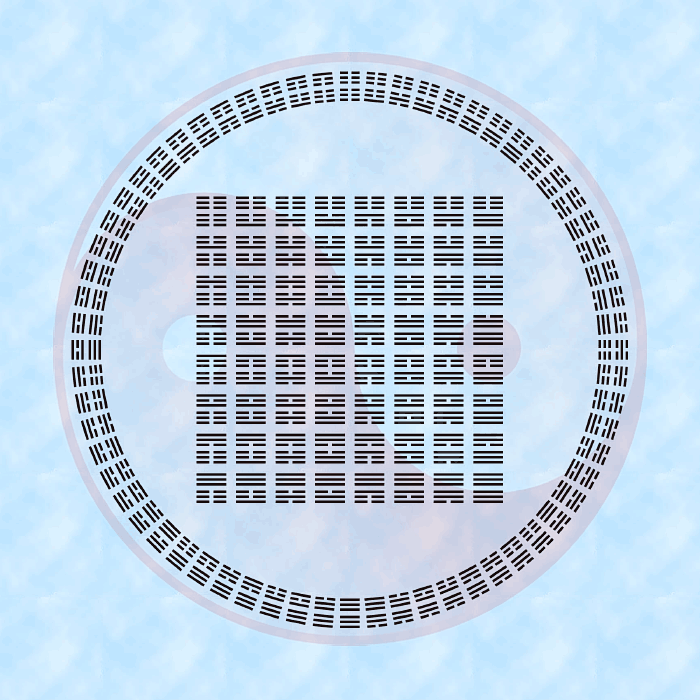
The circle-and-square hexagram arrangement, in modern binary numerical sequence (and clockwise).
The Pang Tong Yao
As previously noted, a hexagram’s “opposite” can be formed in two ways: by physically inverting it, or by reversing the yang lines to yin and vice versa. The former, known as the quian gua, is the method used to create most of the pairs in the traditional King Wen sequence. But not every hexagram has a separate quian gua; if a hexagram is vertically symmetrical, the King Wen sequence pairs it with its reversed polarity opposite, the pang tong gua.
I was wondering what it would be like to ponder the judgment and line pairs formed by listing each hexagram beside its pang tong, rather than quian, gua. Below is such a list; I call these line pairs the pang tong yao. There are some interesting correspondences here and there. A hexagram’s pang tong gua, and the result of changing its lines to form the anti-hexagram as described on the previous page, represent the “negative” of an I Ching reading: what the current situation is not changing into, or what is being avoided by the indicated change.
On a side note, for those who see a relationship between the I Ching and the genetic code, this is the sort of relationship that DNA base pairs have, each line paired with its antisense opposite.
I have used a simple binary sequence for the hexagrams. The decimal and octal (base 8) values of each hexagram are given beside the hexagram image; yin is 0, yang is 1, and the lines are read as a binary number from bottom to top. Note that the octal values are simply the values of the trigrams, and make the hexagrams simple to look up. Below is an index based on the traditional King Wen ordering, and a lookup table illustrating the octal values of the trigrams.
The Fu Xi sequence would be obtained by inverting each hexagram. Note that the important thing about the pang tong yao is the pairings, not the sequence.
| 0 | 8 | 16 | 24 | 32 | 40 | 48 | 56 | ||
| 000 | 001 | 010 | 011 | 100 | 101 | 110 | 111 | ||
| 0 | 000 | 2 | 16 | 8 | 45 | 23 | 35 | 20 | 12 |
| 1 | 001 | 24 | 51 | 3 | 17 | 27 | 21 | 42 | 25 |
| 2 | 010 | 7 | 40 | 29 | 47 | 4 | 64 | 59 | 6 |
| 3 | 011 | 19 | 54 | 60 | 58 | 41 | 38 | 61 | 10 |
| 4 | 100 | 15 | 62 | 39 | 31 | 52 | 56 | 53 | 33 |
| 5 | 101 | 36 | 55 | 63 | 49 | 22 | 30 | 37 | 13 |
| 6 | 110 | 46 | 32 | 48 | 28 | 18 | 50 | 57 | 44 |
| 7 | 111 | 11 | 34 | 5 | 43 | 26 | 14 | 9 | 1 |
Columns are the upper trigrams, rows the lower.
The number at the intersection of a column and row is the
King Wen number for the hexagram.
The sum of the column header and row header is the hexagram’s decimal value
(24 + 1 = 25 for hexagram 17, for example).
The hexagram’s octal value is just the numbers of the two trigrams (31 for hexagram 17).
